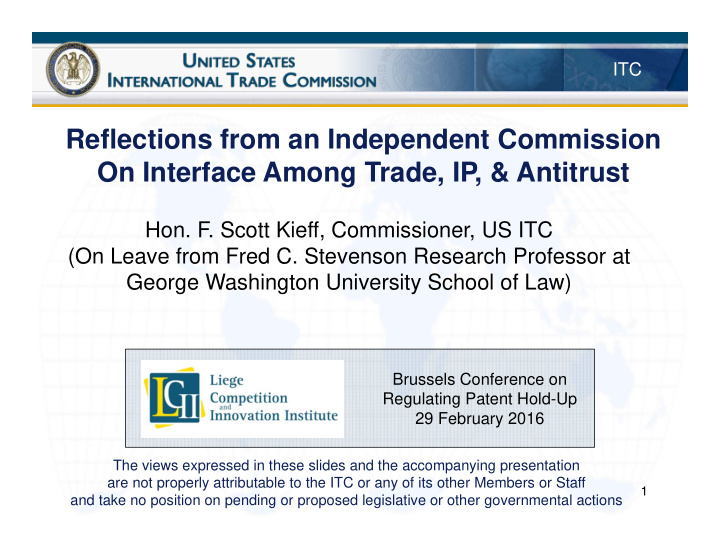



ITC Reflections from an Independent Commission On Interface Among Trade, IP, & Antitrust Hon. F. Scott Kieff, Commissioner, US ITC (On Leave from Fred C. Stevenson Research Professor at George Washington University School of Law) Brussels Conference on Regulating Patent Hold-Up 29 February 2016 The views expressed in these slides and the accompanying presentation are not properly attributable to the ITC or any of its other Members or Staff 1 and take no position on pending or proposed legislative or other governmental actions
ITC ITC Office-Level Organization Chart (noting some often overlooked assets) Commission (Six Commissioners) • Diverse professional backgrounds • Each office with three advisors as mid-career professionals in law & economics Administrative Law Operations Others General Counsel Judges (OALJ) (OGC) • Substantive law • Substantive law • Administrative law • Complex litigation Unfair Import Investigations Economics Industries Investigations (OUII) (OINV) (OECON) (OIND) • Substantive law • Surveys • Valuations • Technology • Complex litigation • Analysis • Modeling • Business 2
ITC ITC Structure: Independence & Collaboration • Six Commissioners: 1 vote each on substance • Statutorily structured in shadow of Civil War (tariffs before income tax) • Adjudicatory role, applies law as given by Congress and interpreted by courts (Rules-based decision-making on IP, Antitrust, and Trade) • No more than three members of same political party, with Presidential nomination and Senate confirmation • Nine-year, non-renewable, staggered terms • Chair changes party every two years • Four can overrule Chair on administration (Daily & Kieff, Benefits of Patent Jury Trials for Commercializing Innovation, 21 Geo Mason L Rev 865 (2014)) 3
ITC Many Agencies of the US Patent System (Increasing mix of topics & increasing political independence) Courts Executive Branch Independent SCT Agencies Commissions PTO DoJ FTC ITC CADC* CAFC Antitrust Validity Antitrust District Courts Validity, Infringement, Remedies, Antitrust 4
ITC Perspectives on Property Rights’ Web of Contracts around Patents in a Well-Operating System Inventor (or her employer) Returns to investment in invention 2 nd parties contract over patent Returns to investment in commercialization • Venture capitalists • Joint venture partners • Outsiders who license or buy 3 rd parties Avoid infringement or contract to license or buy New goods, services, & business models brought to market Consumers • Access to these new options • Increased competition brought to legacy options Everyone No need for government to trace contributions or allocate values because parties themselves made allocations through contracts, at least implicitly (Kieff, Coordination, Property & Intellectual Property: An Unconventional Approach to Anticompetitive Effects 5 & Downstream Access , 56 Emory L.J. 327 (2006); Kieff, On Coordinating Transactions in Information: A Response to Smith’s Delineating Entitlements in Information , 117 Yale L.J. Pocket Part 101 (2007))
ITC What Can Patent System Questions about Hold-Up Learn from History? Ask Nobel Laureate Oliver Williamson: Asset specificity • Asset cannot be redeployed from current, reasonably intended use to some alternative use without a decline in value Williamson, The Economic Institutions of Capitalism, 52–56 (1985) Plus Opportunism • self-interest seeking with guile, including calculated efforts to mislead, deceive, obfuscate, and otherwise confuse Williamson, The Mechanisms of Governance, 378 (1996) 6
ITC Holdup Risks in Context of Patent Remedies • Patent holdup (all 3 of the following) • At least some minimal level of advance patent clearance attempted by infringer • Infringer then invests sunk costs in reasonable reliance, and the sunk costs are large and asset specific • Opportunism by patentee • Reverse holdup • Patentees and contracting parties strung along by opportunistic infringers holding out for patentee to cave • Delay in selecting standard or threat of picking bad one • Government holdup • Patentees and contracting parties learn later that infringers get preferred treatment (Epstein, Kieff, Spulber, The FTC, IP, and SSOs: Government Hold-up Replacing Private Coordination , 8 J. C OMPET . L. AND E CON . (2012); Kieff & Layne-Farrar, Incentive Effects from Different Approaches to Holdup Mitigation Surrounding Patent Remedies and Standard-Setting Organizations, 7 9 J. Competition L. & Econ. 1091 (2013))
ITC SSOs, Patents, & ITC: Details of Parties’ Behaviors Matter a Lot for Both Substance & Process • Broadcom v. Qualcomm (337-TA-543, 2007) “baseband processors” public interest public hearing • https://www.usitc.gov/press_room/news_release/2007/er0607ee1.htm • https://www.law.cornell.edu/cfr/text/19/210.43 • Samsung v. Apple (337-TA-794, 2013) “smartphone wars” • http://www.essentialpatentblog.com/2013/07/itc-releases-public-version-of-the-commission-opinion-and-dissent-in-samsung-apple-case-337-ta-794/ • http://www.essentialpatentblog.com/2013/08/u-s-trade-representative-vetoes-exclusion-order-in-samsung-apple-itc-case-inv-no-337-ta-794-no-iphoneipad-ban/ • Amkor v. Carsem (337-TA-501, 2014) “encapsulated integrated circuits” and JEDEC, with additional views of Aranoff, Broadbent, Kieff, and Pinkert • http://www.essentialpatentblog.com/2014/05/itc-issues-limited-exclusion-order-upon-finding-patent-was-not-essential-to-jedec-standard-337-ta-501/ • http://www.essentialpatentblog.com/wp-content/uploads/sites/234/2012/12/2016.01.28-SEP-Litigation-in-ITC-D.-Long.pdf • Tomorrow’s discussions under the Sunshine Act: “parties … may submit a written request for a hearing to present oral argument…. The Commission shall grant the request when at least one of the participating Commissioners votes in favor of granting the request.” • https://www.law.cornell.edu/cfr/text/19/210.45 • http://www.essentialpatentblog.com/2016/02/help-us-help-you/ • Why limit the analytical benefit of open conversations about complex topics to just SEPs and the like….? 8
Recommend
More recommend